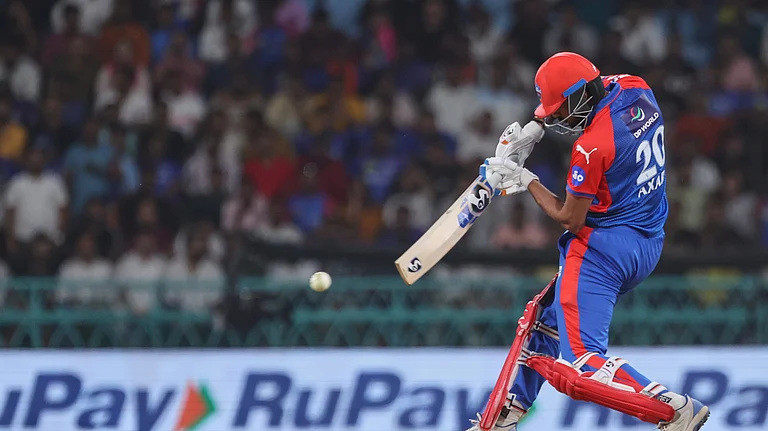"It is (even more) unacceptable that India claims to have conducted the tests to counter what it called a China threat."
- Chinese Vice-Premier Qian Qichen, in the Peoples Daily, May 20, 1998.
M UCH water has flowed down the Yangtze since that statement was made. In that time, India has managed to patch, if not mend, fences with most of the powers that had reacted with shocked anger at Indias nuclear tests. US President Bill Clintons endorsement of India, Russias and Frances reiteration of support to Indias candidature for a permanent seat at the UN security council, UK foreign secretary Robin Cooks India visit, President K.R. Narayanans visit to France-all indicate that the major powers have, however grudgingly, accepted that India is now a nuclear power as well as a major economic one.
President Narayanan is also slated to visit China from May 28 to June 3. But at the 12th Sino-Indian Joint Working Group (JWG) meeting in Delhi last week, there was no official sign of Beijing softening its demand that New Delhi initiate a complete rollback of its N-weapons programme as per UN Security Council resolution 1172.
Begun after Rajiv Gandhis visit to China in 1988, the JWG is a forum which has increasingly focused more on peace along the border than on a real solution to the boundary problem. And to that extent, it has been reasonably successful. This time, the Indian delegation was headed by foreign secretary Lalit Mansingh, while the Chinese team was led by a vice-foreign minister, Yang Wenchang. But, as Jaswant Singh himself admitted in Parliament on April 26, the boundary dispute is not even close to being resolved. The Indian position is that China continues to illegally occupy 38,000 sq km of Indian territory in Kashmir, besides the 5,180 sq km ceded by Pakistan to China. On its part, Beijing lays claim to 90,000 sq km of territory in Arunachal Pradesh.
That doesnt mean theres been no progress in improving bilateral ties. Foreign minister Jaswant Singh visited Beijing last June and agreed to a formalised annual strategic dialogue, inaugurated in Beijing in March this year. Chinas and Indias positions on the WTO are near-identical and commerce minister Murasoli Maran too visited China recently to conclude an agreement on Beijings entry into the WTO. And India voted against a US resolution condemning Chinas human rights record at Geneva, a fact acknowledged by Chinese foreign minister Tang Jiaxuan in a letter to Singh.
On the N-issue, "theyre peddling the line that its not them but part of the UN resolution", says analyst and China expert K.N. Ramachandran, who interacted with a Chinese Track II delegation recently. "I told them they dont have to keep harping on it, they dont have to tell the US to pressure us on CTBT.... In other words, dont make it part of the Sino-Indian dialogue."
But a senior foreign ministry official downplays differences. Post-Pokhran, he says, "there was no cooling down in bilateral ties, no talk of sanctions by Beijing". In fact, bilateral trade actually rose. And during the Kargil crisis, on July 2, 1999, two days after Nawaz Sharifs visit to Beijing, China issued a significant statement. Three major elements of that: India and Pakistan should resolve disputes bilaterally; the LoC must be respected; and a reference to the Lahore accord, "which incorporates the Simla agreement".
Swaran Singh of the idsa says one main thrust of the discussions at the JWG is Sikkim, whose integration into India is still not recognised by Beijing. "We should push them to say yes on Sikkim," says Singh, and one way of expressing Indias good faith would be to assert that the Karmapa would not be allowed into that state.
Requesting anonymity, another China expert pointed out that Beijing may be miffed over Indias dithering over a proposal for sub-regional cooperation, which envisages easy trade between Yunan and Sichuan-two of Chinas poorest provinces-Indias northeast, Burma and Bangladesh. India fears such a deal would flood the region with cheap Chinese goods, besides leading to a rise in arms and drug traffic.
But C.V. Ranganathan-Indias ambassador to China from 1987 to 1991 and co-author of India and China, The Way Ahead-feels its time for such a grouping. "Not accepting this is a limited and negative approach. Why cant we understand that we too can reach a sizeable chunk of the Chinese market?" he asks. On the JWG, he feels theres been a lack of political consensus on how to resolve the border dispute. "Theres been no focus, due to the coalitions and other factors here. The importance of the JWG in ensuring peace, pushing forward bilateral visits and enhancing mutual understanding on international issues cant be underestimated. But you cant expect the JWG to perform miracles".
Swaran Singh is cautiously optimistic about the "sudden rise in bilateral traffic" since January. "When the world is moving towards India, the Chinese are keen to know how close we are to the other powers, mainly the US." But another China watcher says the new-found bonhomie between New Delhi and Washington has Beijing a "bit uncomfortable, there is a sense of disquiet". But, he adds, this is a positive thing as "they are now realising that India is emerging as major and independent power and can in no way be treated at par with Pakistan". Which can only be good thing.





















